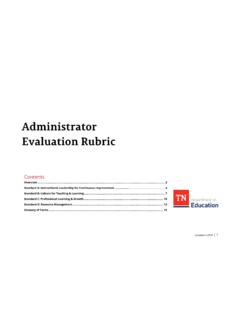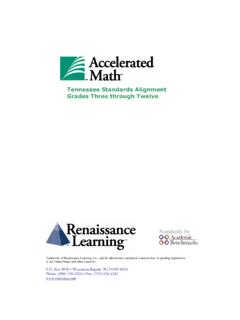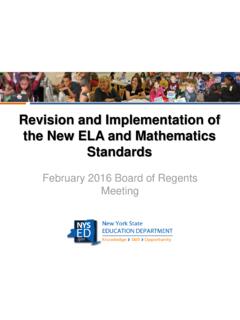Transcription of 2017-18 Pre-K/K Math Resource Guide - TEAM-TN
1 2017-18 Pre-K/K math Resource GuideJune 8, 2017 Keely Potter | Director of Teacher Effectiveness | Spring 2017To review the 2017-18 Pre-K/K math Resource Guide , which includes the following: Mathematics Portfolio Planning Guide :This is an optional tool that teachers can use to plan for the collection of student work artifacts for math . Mathematics Scoring Guide :This is a standards -based tool that identifies the criteria and descriptors of each performance level and will be used to score student work artifacts for of Today s WebinarStudent Growth Portfolio Model Overview To provide pre-K and kindergarten teachers the opportunity to demonstrate the best growth in students of various proficiency levels through purposeful sampling To ensure that teachers are honored for implementing the revised TN standards presented in a way that promotes higher reading comprehension and math proficiencyPurpose of PortfolioTotal collections to submit.
2 4 ELAM athliterature/narrative text counting & cardinalityinformational/explanatory text geometry or measurement & data*ELA will combine standardsfrom across the foundational, reading andwriting Portfolio ComponentsTotal collections to submit: 4 ELAM athliterature/narrative text counting & cardinalityinformational/explanatory text operations & algebraic thinking*ELA will combine standardsfrom across the foundational, reading andwriting Portfolio ComponentsPWhy student growth portfolio model?Professional Learning and GrowthFlexible AssessmentPeer ReviewedStudent CenteredTeacher DevelopedStudent Growth Portfolio Model Drives teacher-generated assessment (formative) Drives differentiation/small group instruction Builds reflection in teachers andstudents Fosters collaboration in PLCs/collaborative teacher groups Connects to students making their own goals and assessing their growth along the way Fosters student talk about student work Increases effective teacher planning Deepens content knowledge about deconstructing standards Shows authentic strength and areas of need in individual studentsStudent Work at the Center As part of a teacher s normal cycle of planning, instruction, and reflection, a variety of targeted learning objectives should be outlined for use throughout the school year.
3 Teachers collect the student growth evidence from the two points in time that are the most practical for the specific standards -based learning taking place. Teachers are encouraged to be thoughtful in determining what evidence provides the clearest picture of their impact on student learning for multiple levels of students. Collection Points for Point A and Point BPossible evidence: Video segments that demonstrate student actions or talk Photographs of student work Audio of student talkPoint A and Point B Samples Student work artifacts can be stored using any district-approved Resource ( , free, cloud-based storage service, external hard drive, classroom files or folders, etc.). Student work artifacts can be stored in the online platform after October should teachers keep student work artifacts as they are being collected?NarrativeLLiving in the Portfolio self-score context description of the workLiving outside the portfolioself-reflectionanecdotal noteson student workPLCs Principles of Scoring Seven-level rubric to capture growth beyond levels four and five Scored by peers Growth levels and teacher effectiveness ratings are calculated based on student scores Uses Educopia System Teachers will have the flexibility to upload multiple files for any given assessment Teachers tag evidence on the actual student work and generate scores based on evidencePre-K/K Portfolio2016-17 Teacher Effectiveness Indicators for Student Growth Portfolio Models (includes fine arts, K-5, pre-K/kindergarten, first grade)
4 Level 5 Significantly Above Expectations Students demonstrated, on average, three levels of student growth, OR two levels of student growth plus evidence of student critical thinking.* Level 4 Above Expectations Students demonstrated, on average, approximately two levels of student growth, OR one level plus evidence of student critical thinking.* Level 3 At Expectations Students demonstrated, on average, one level of student growth. Level 2 Below Expectations Students demonstrated, on average, less than one level of growth. Level 1 Significantly Below Expectations Students demonstrated, on average, little to no growth. *Student critical thinking may include metacognitive processes; knowledge and skills; risk taking, imaginationand voice; and a range of abilities with technique, problem solving and Teacher Effectiveness Indicators172017-18 Teacher Effectiveness IndicatorAch Measure15%Growth Measure35%Qualitative50%Where do portfolios fit within evaluation?
5 Portfolios generate an individual growth measure (individual TVAAS score) Part of the quantitative component of evaluationWe will now pause and answer any questions you have so far. Please submit your questions via the chatboxto Amanda Armstrong. Pause for Q&AThe Pre-K & KindergartenMathematics Scoring Guide Most of the structure of the previous state standards has been maintained because it is logical, informative, and easy to follow. Most tennessee teachers are already familiar with the structure. math Instructional Shifts and the PortfolioStructure of the standards Content standards Clusters Domains Conceptual Categories*Additional information found on page 5 of the tennessee math standards LanguageMathematics Scoring Guide :This is a standards -based tool that identifies the criteria and descriptors of each performance level and will be used to score student work artifacts for Scoring GuidePre-K/K math Portfolio Resource GuideSteps of the Portfolio ProcessMath PortfolioPlanning GuidesPause for Q&AWe will now pause and answer any questions you have so far.
6 Please submit your questions via the chatbox to Amanda Armstrong. Pre-Kindergarten Scoring Guide Verbally count forward in sequence from 1 30. Understand the relationships between numerals, names of numerals and quantities up to 10 (includes subitizing the ability to look at a quantity and say the quantity [1-4] quickly, just by looking.*Note: Each standard stands alone and is not integrated in the mathematics scoring guidePre-K Counting and Cardinality standards : Know number names and the count sequencePre-K Counting and Cardinality Scoring Guide : Know number names and the count sequence Use one-to-one correspondence to accurately count up to 10 objects in a scattered configuration. With guidance and support, count to answer how many? questions about as many as 10 things arranged in a line or as many as 5 things in a scattered configuration; given a number from 1-10, count out that many objects.)
7 *Note: Each standard stands alone and is not integrated in the mathematics scoring guidePre-K Counting and Cardinality standards : Count to tell the number of objectsPre-K Counting and Cardinality Scoring Guide : Count to tell the number of objects Use comparative language, such as more/less than or equal to, to compare and describe collections of objects by Counting and Cardinality standards : Compares numbersPre-K Counting and Cardinality Scoring Guide ; Compares numbersDescribe and compare measurable attributes; Classify objects and count the number of objects in each category Explores the concept of measurement to compare the attributes or two or more concrete objects and use words to define attributes of the objects ( , heavier/lighter, longer/shorter, covers more/ covers less, holds more/ holds less).Classify objects and count the number of objects in each category Sorts, categorizes, and classifies objects by more than one attribute.
8 *Note: Each standard stands alone and is not integrated in the mathematics scoring guidePre-K Measurement and Data StandardsPre-K Measurement and Data Scoring GuideDescribe and compare measurable attributes; Classify objects and count the number of objects in each category Identifies relative positions of objects in space, and uses appropriate language ( , beside, inside, next to, close to, above, below, apart). Identifies four basic shapes ( , square, circle, triangle, rectangle, and hexagon) in the classroom setting or real-world environment.*Note: Each standard stands alone and is not integrated in the mathematics scoring guidePre-K Geometry standards :Identify and describe sharesPre-K Geometry Scoring Guide : Identify and describe shares With guidance and support, compares and contrasts the attributes of three-dimensional shapes of different sizes and orientations, identifying shapes that are ___and shapes that are not___.
9 With guidance and support, creates and names new shapes formed when putting two shapes together ( , two right triangles of the same size put together would make a rectangle or square).*Note: Each standard stands alone and is not integrated in the mathematics scoring guidePre-K Geometry standards :Analyze, compare, create, and compose shapes Pre-K Geometry Scoring Guide : Analyze, compare, create, and compose shapes We will now pause and answer any questions you have so far. Please submit your questions via the chatboxto Amanda Armstrong. Pause for Q&AKindergarten Scoring Guide Count to 100 by ones, fives, and tens. Counts backward from 10. Count forward beginning from a given number within the known sequence (instead of having to begin at 1). Write numbers from 0 to 20. Represents a number of objects with a written numeral 0-20.
10 *Note: Each standard stands alone and is not integrated in the mathematics scoring and Cardinality standards ; Know number names and counting sequenceCounting and Cardinality Scoring Guide : Know number names and counting sequence , 4b, 4c: When counting objects, say the number names in the standard order, pairing each object with one and only one number name and each number name with one and only one object (up to 20); recognize that the last number name said tells the numbers of objects counted. The number of objects is the same regardless of their arrangement or the order in which they were counted (up to 20); and recognize that each successive number name refers to a quantity that is one greater (up to 20).*This is one and Cardinality standards : Count to tell the number of objectsCounting and Cardinality Scoring Guide :Count to tell the number of objects Count to answer how many?
















